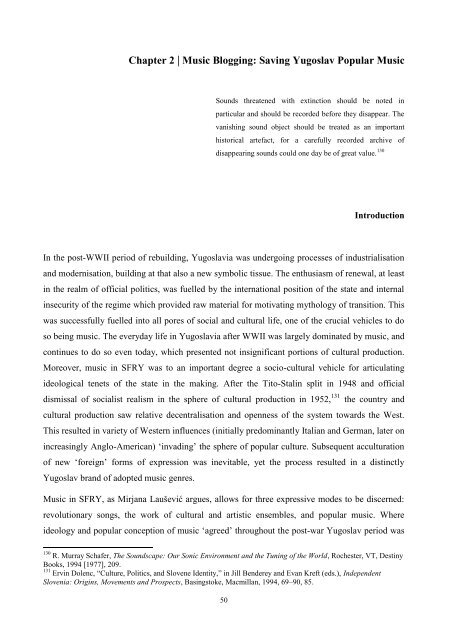UNIVERSITY OF NOVA GORICA GRADUATE SCHOOL ...
UNIVERSITY OF NOVA GORICA GRADUATE SCHOOL ...
UNIVERSITY OF NOVA GORICA GRADUATE SCHOOL ...
You also want an ePaper? Increase the reach of your titles
YUMPU automatically turns print PDFs into web optimized ePapers that Google loves.
Chapter 2 | Music Blogging: Saving Yugoslav Popular Music<br />
Sounds threatened with extinction should be noted in<br />
particular and should be recorded before they disappear. The<br />
vanishing sound object should be treated as an important<br />
historical artefact, for a carefully recorded archive of<br />
disappearing sounds could one day be of great value. 130<br />
Introduction<br />
In the post-WWII period of rebuilding, Yugoslavia was undergoing processes of industrialisation<br />
and modernisation, building at that also a new symbolic tissue. The enthusiasm of renewal, at least<br />
in the realm of official politics, was fuelled by the international position of the state and internal<br />
insecurity of the regime which provided raw material for motivating mythology of transition. This<br />
was successfully fuelled into all pores of social and cultural life, one of the crucial vehicles to do<br />
so being music. The everyday life in Yugoslavia after WWII was largely dominated by music, and<br />
continues to do so even today, which presented not insignificant portions of cultural production.<br />
Moreover, music in SFRY was to an important degree a socio-cultural vehicle for articulating<br />
ideological tenets of the state in the making. After the Tito-Stalin split in 1948 and official<br />
dismissal of socialist realism in the sphere of cultural production in 1952, 131 the country and<br />
cultural production saw relative decentralisation and openness of the system towards the West.<br />
This resulted in variety of Western influences (initially predominantly Italian and German, later on<br />
increasingly Anglo-American) ‗invading‘ the sphere of popular culture. Subsequent acculturation<br />
of new ‗foreign‘ forms of expression was inevitable, yet the process resulted in a distinctly<br />
Yugoslav brand of adopted music genres.<br />
Music in SFRY, as Mirjana Laušević argues, allows for three expressive modes to be discerned:<br />
revolutionary songs, the work of cultural and artistic ensembles, and popular music. Where<br />
ideology and popular conception of music ‗agreed‘ throughout the post-war Yugoslav period was<br />
130 R. Murray Schafer, The Soundscape: Our Sonic Environment and the Tuning of the World, Rochester, VT, Destiny<br />
Books, 1994 [1977], 209.<br />
131 Ervin Dolenc, ―Culture, Politics, and Slovene Identity,‖ in Jill Benderey and Evan Kreft (eds.), Independent<br />
Slovenia: Origins, Movements and Prospects, Basingstoke, Macmillan, 1994, 69–90, 85.<br />
50

















